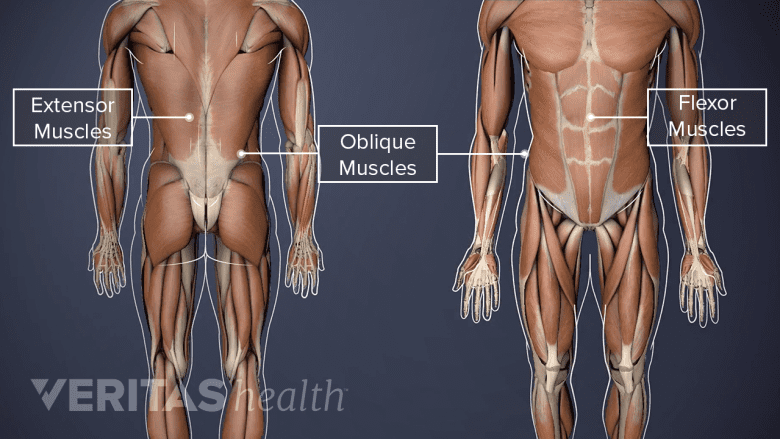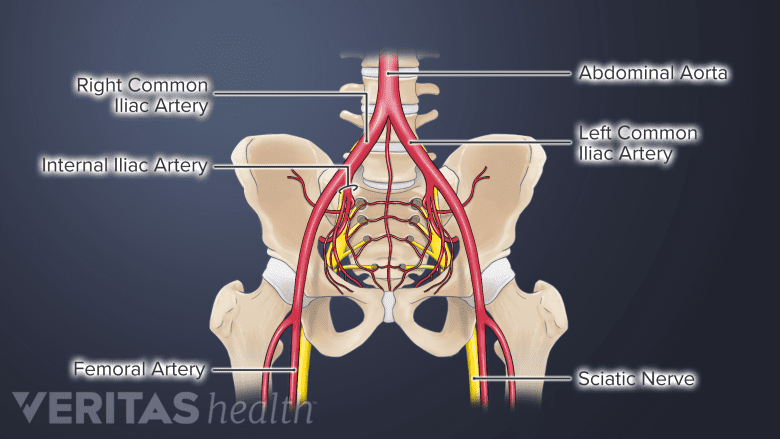The supporting soft tissues of the lower back contain a network of muscles and ligaments. These tissues provide stability and strength to the lower back and facilitate spinal movements, such as bending and twisting. The lumbar spine receives its blood supply and nutrition from branches of the large abdominal aorta.
In This Article:
Lumbar Muscles

The lumbar spine is supported by 3 muscle groups.
There are several muscles in the lumbar spine, which can be categorized into 3 groups depending on their function.
- The extensor muscles help hold up the spine and assist in extending the spine (bending backward).
- The flexor muscles enable flexing the spine (bending forward), lifting, and arching the lower back.
- The oblique muscles help rotate the spine and maintain proper posture.
The lumbar muscles are arranged in several layers. Many muscles originate in the sacrum (lower part of the spine) or pelvis and insert in the upper back or the neck region. The lumbar muscles work along with the abdominal muscles to coordinate movements of the trunk and lower back.
A few important muscles include:
- Erector spinae: Also known as paraspinal muscles, these are a large group of muscles that run from the lower spine to the neck. The muscles from this group specific to the lumbar spine include:
- Iliocostalis lumborum
- Longissimus thoracis
- Lumbar multifidus: A thin strip of deep muscle that inserts into the vertebrae.
- Quadratus lumborum: A deep abdominal muscle that connects the hip to the lumbar vertebrae.
The lumbar muscles help support the spine. When subject to additional loads (such as from an incorrect lifting technique, swinging a golf club the wrong way, or weight from a protruding abdomen), these muscles can get overstretched, strained, or torn.
Read more about Back Muscles and Low Back Pain
Lumbar Ligaments

The spinal ligaments help facilitate motion, absorb loads, and protect the spinal cord.
Soft tissues that connect bones together are called ligaments. Ligaments are tough, flexible bands of connective tissue that allow smooth motion of the spine, protect the spinal cord by limiting excessive motion, and help absorb loads during trauma.1Cramer GD. General Characteristics of the Spine. In: Clinical Anatomy of the Spine, Spinal Cord, and Ans. Elsevier; 2014:15-64. doi:10.1016/b978-0-323-07954-9.00002-5
Important ligaments of the lumbar spine include:
- Anterior longitudinal ligament: Connects the anterior (front) surfaces of adjacent vertebral bodies and stabilizes the spine during extension (backward bending).
- Posterior longitudinal ligament: Connects the posterior (back) surfaces of adjacent vertebral bodies and stabilizes the spine during flexion (forward bending).
- Ligamentum flavum: These are short, paired ligaments that connect the vertebral arches of adjacent vertebrae, helping to cover the spinal cord from behind. The lumbar ligamentum flava are the thickest of the entire spine.
- Supraspinous and interspinous ligaments: These ligaments are present between adjacent spinous processes and limit lumbar flexion. The interspinous ligaments are the first to sprain during hyperflexion (excessive forward bend) of the lumbar spine.2Cramer GD. The Lumbar Region. In: Clinical Anatomy of the Spine, Spinal Cord, and Ans. Elsevier; 2014:246-311. doi:10.1016/b978-0-323-07954-9.00007-4
- Intertransverse ligaments: These ligaments connect adjacent transverse processes and limit lateral movements.
Other ligaments in the lower back include the iliolumbar ligaments, which are only present in the lumbar spine and provide additional support.
Lumbar Blood Vessels

The lumbar spine receives its blood supply through the branches of the abdominal aorta.
The blood supply to the lumbar spine is facilitated through branches of the large abdominal aorta, which descends down the front of the lumbar vertebral bodies. Four or 5 paired lumbar arteries branch off this aorta and send blood to the muscles, ligaments, and the vertebral bodies. These arteries are accompanied by lumbar veins that carry deoxygenated blood back to the heart.2Cramer GD. The Lumbar Region. In: Clinical Anatomy of the Spine, Spinal Cord, and Ans. Elsevier; 2014:246-311. doi:10.1016/b978-0-323-07954-9.00007-4
Abnormal thickening of the wall of the abdominal aorta may cause a life-threatening condition called abdominal aortic aneurysm. The condition can cause significant abdominal pain and back pain and may lead to the artery’s leak or rupture, at which point it becomes a medical emergency.
- 1 Cramer GD. General Characteristics of the Spine. In: Clinical Anatomy of the Spine, Spinal Cord, and Ans. Elsevier; 2014:15-64. doi:10.1016/b978-0-323-07954-9.00002-5
- 2 Cramer GD. The Lumbar Region. In: Clinical Anatomy of the Spine, Spinal Cord, and Ans. Elsevier; 2014:246-311. doi:10.1016/b978-0-323-07954-9.00007-4

